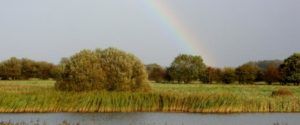This was the driest, coldest day of the year so far but the recent deluge was evident in all the fields and on the paths. Setting off from Roecliffe, we walked through a small copse where Colin showed us a huge, active badger sett, unusual in it being on flat ground, not into a bank. On leaving the wood the six of us slithered and slipped our way round field edges and footpaths. It was very pleasing to see good numbers of Meadow Pipits, Yellowhammers, Skylarks, Chaffinches, Fieldfares and Redwings, along with a few Song and Mistle Thrushes feeding in stubble and sheep fields.
Raptors were limited to several Buzzards and a Kestrel but strangely, no Red Kites. Yellowhammers, Tree Sparrows and Reed Buntings formed small flocks at the Staveley Nature Reserve, and on the feeders were Blue, Great and Willow Tits. By the end of the walk we had seen several Hares and a buck Roe Deer with three hinds.
Muff and Jack very kindly hosted us for lunch at The Paddocks and while eating our picnics in comfort and warmth, we watched Nuthatch and Coal Tit come to their feeders, amongst the Tree and House Sparrow flock.
Setting off after lunch we walked back through the reserve adding Long-eared Owl, more Goldeneye and a Kingfisher to our list. By the time we had reached Roecliffe again our bird count had gone up to 56 and we had evaded the wintry showers which had been forecast for the late afternoon. Our finale was a flock of about 200 mixed Fieldfares and Redwings, with a ratio of 75/25.
Excellent! Many thanks to Colin for a very interesting and informative look at farmland and ings management. It was clear that some farming practices can provide for, and allow for, wildlife while others completely disregard it. Thankfully there was some winter food to be had, but many, many fields were sadly bereft of all birdlife and lay barren and sterile awaiting another intensive crop to be sprayed and manicured. Colin’s recollections of times gone by, when copses and fields weren’t used for Pheasant rearing were only to be marvelled at.
Sue Coldwell

